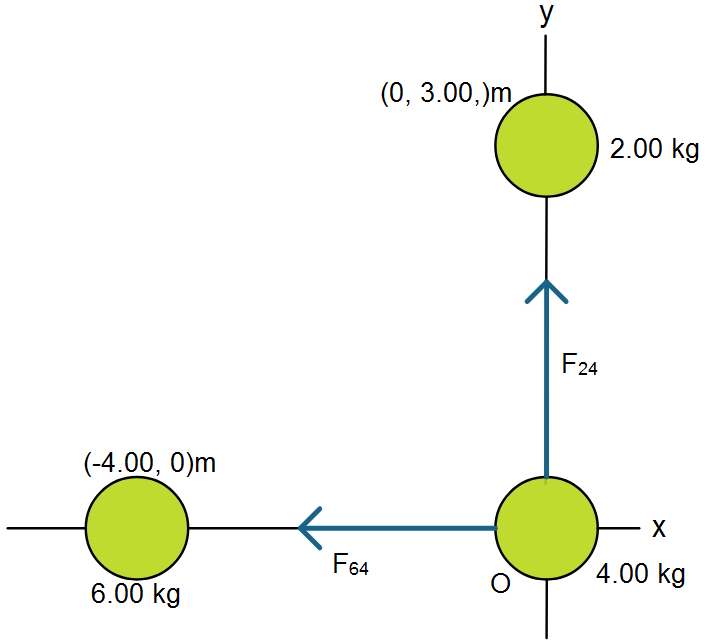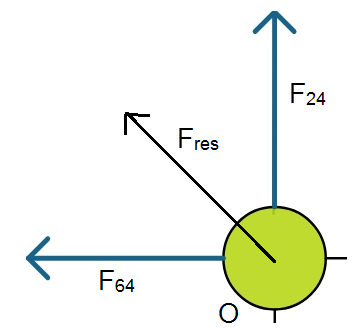
Three uniform spheres of mass 2.00 kg, 4.00 kg and 6.00 kg are placed at the corners of a right triangle as in the figure. Assuming the spheres are isolated from the rest of the universe, choose the correct statements from the following.

(A) The resultant gravitational force on the 4.00 kg object is (-100$\hat{i}$ + 59.3$\hat{j}$) pN
(B) There resultant gravitational force on the 4.00 kg object is (-50$\hat{i}$ + 59.3$\hat{j}$) pN
(C) If the 2.00 kg object and the 6.00 kg object are interchanged the magnitude of the resultant gravitational force on the 4.00 kg object remains the same.
(D) If the 2.00 kg object and the 4.00 kg object are interchanged then the resultant gravitational force on the 2.00 kg object is (-50$\hat{i}$ + 59.3$\hat{j}$) pN.

Answer
571.5k+ views
Hint: The magnitude of the vectors displayed in the question diagram can be determined using the usual gravitational force expression. The resultant can be calculated using parallelogram law of vector addition.
Formula used:
Between any two masses, the force of gravity experienced is written as:
$F_{21} = F_{12} = G \dfrac{m_1 m_2}{r^2}$
(in magnitude).
Complete answer:
We deal with all the options one by one;
(A). The resultant force on 4 kg mass is the vector sum of the forces between 2 kg and 4 kg mass and 6 kg and 4 kg mass.
First, let us write the magnitude of force between 6 kg and 4 kg:
$F_{64} = 6.67 \times 10^{-11} \times \dfrac{6 \times 4}{4^2} = 1.001 \times 10^{-10}$ N = 100 pN (approx.)
Similarly, between 2 kg and 4 kg mass we have:
$F_{24} = 6.67 \times 10^{-11} \times \dfrac{2 \times 4}{3^2} = 5.932 \times 10^{-11}$ N = 59.3 pN (approx.)

We apply parallelogram law of vector addition so that the resultant we get is
$F_{res} = -100\hat{i} + 59.3 \hat{j}$
Therefore option (A) is a correct statement.
(B) Now, as we already established (A) is correct this clearly means that the statement (B) has to be incorrect.
(C). This statement is also incorrect because the magnitude of the gravitational force not only depends on the masses but also depends on the distance of separation. If we change the position of the masses, the resultant will not remain the same.
(D). The force between 2 kg and 4 kg will still have the same magnitude as we had previously, which was 59.3 pN.
The magnitude of force between 2 kg and 6 kg will be:
$F_{62} = 6.67 \times 10^{-11} \times \dfrac{6 \times 2}{4^2} = 5.005 \times 10^{-11}$ N = 50 pN (approx.).
Therefore the statement in option (D) is also correct.
So, the correct answer is “Option A and D”.
Note:
The vector addition has to be performed keeping in mind the positive or negative directions on the x or y axis. As on the x axis, our force vector points in negative x direction, the force will be taken as negative. Along the y direction, the force is along a positive y direction, so it is taken positively. Mind that even when the force would have depicted towards the negative side of x axis, but if the arrow of the vector points towards +x direction, the force had to be taken positively.
Formula used:
Between any two masses, the force of gravity experienced is written as:
$F_{21} = F_{12} = G \dfrac{m_1 m_2}{r^2}$
(in magnitude).
Complete answer:
We deal with all the options one by one;
(A). The resultant force on 4 kg mass is the vector sum of the forces between 2 kg and 4 kg mass and 6 kg and 4 kg mass.
First, let us write the magnitude of force between 6 kg and 4 kg:
$F_{64} = 6.67 \times 10^{-11} \times \dfrac{6 \times 4}{4^2} = 1.001 \times 10^{-10}$ N = 100 pN (approx.)
Similarly, between 2 kg and 4 kg mass we have:
$F_{24} = 6.67 \times 10^{-11} \times \dfrac{2 \times 4}{3^2} = 5.932 \times 10^{-11}$ N = 59.3 pN (approx.)

We apply parallelogram law of vector addition so that the resultant we get is
$F_{res} = -100\hat{i} + 59.3 \hat{j}$
Therefore option (A) is a correct statement.
(B) Now, as we already established (A) is correct this clearly means that the statement (B) has to be incorrect.
(C). This statement is also incorrect because the magnitude of the gravitational force not only depends on the masses but also depends on the distance of separation. If we change the position of the masses, the resultant will not remain the same.
(D). The force between 2 kg and 4 kg will still have the same magnitude as we had previously, which was 59.3 pN.
The magnitude of force between 2 kg and 6 kg will be:
$F_{62} = 6.67 \times 10^{-11} \times \dfrac{6 \times 2}{4^2} = 5.005 \times 10^{-11}$ N = 50 pN (approx.).
Therefore the statement in option (D) is also correct.
So, the correct answer is “Option A and D”.
Note:
The vector addition has to be performed keeping in mind the positive or negative directions on the x or y axis. As on the x axis, our force vector points in negative x direction, the force will be taken as negative. Along the y direction, the force is along a positive y direction, so it is taken positively. Mind that even when the force would have depicted towards the negative side of x axis, but if the arrow of the vector points towards +x direction, the force had to be taken positively.
Recently Updated Pages
Why are manures considered better than fertilizers class 11 biology CBSE

Find the coordinates of the midpoint of the line segment class 11 maths CBSE

Distinguish between static friction limiting friction class 11 physics CBSE

The Chairman of the constituent Assembly was A Jawaharlal class 11 social science CBSE

The first National Commission on Labour NCL submitted class 11 social science CBSE

Number of all subshell of n + l 7 is A 4 B 5 C 6 D class 11 chemistry CBSE

Trending doubts
Differentiate between an exothermic and an endothermic class 11 chemistry CBSE

10 examples of friction in our daily life

One Metric ton is equal to kg A 10000 B 1000 C 100 class 11 physics CBSE

Difference Between Prokaryotic Cells and Eukaryotic Cells

1 Quintal is equal to a 110 kg b 10 kg c 100kg d 1000 class 11 physics CBSE

State the laws of reflection of light




